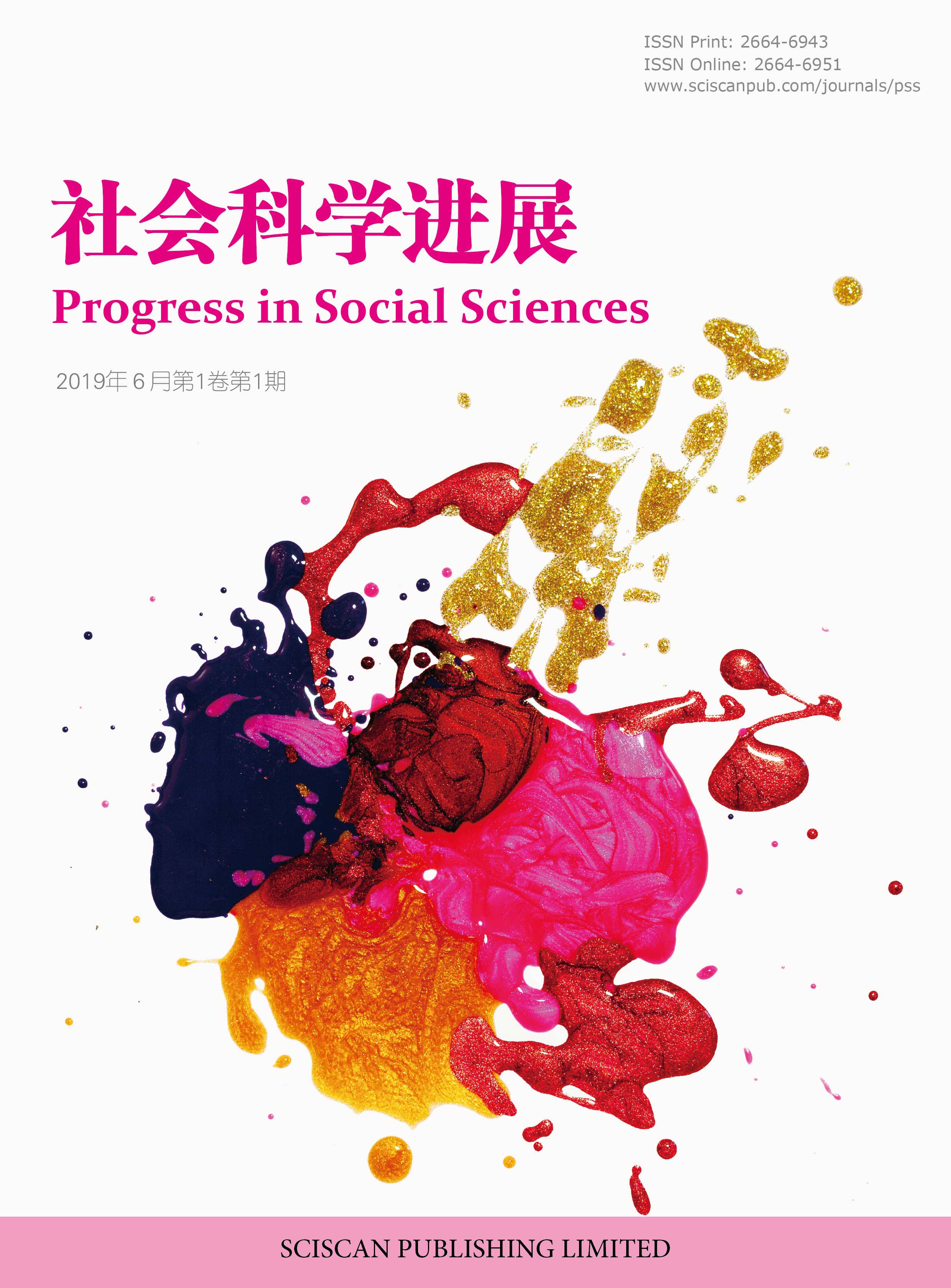Progress in Social Sciences
未成年人刑罚威慑效能研究及优化策略
Research on the Deterrence Effectiveness of Penalties for Minors and Optimization Strategies
- Authors: 唐诗 何佳龄
-
Information:
上海政法学院,上海
-
Keywords:
Juvenile delinquency; Penal deterrence of criminal law; Crime prevention未成年人犯罪:刑法威慑; 犯罪预防
- Abstract: In the construction of a society ruled by law, criminal law plays a crucial role in maintaining social order and safeguarding citizens’ rights and interests. However, with the development of society, juvenile delinquency has shown trends of younger age of offenders, more complex means, and increasingly serious nature, becoming a prominent social issue. The reduction of the minimum age of criminal responsibility in the Eleventh Amendment to the Criminal Law is a proactive response to these challenges. This amendment aims to strengthen the education and protection of minors and provide legal support for the prevention and suppression of crimes committed by them. The theory of penal deterrence has evolved through various stages, including the era of retributive punishment, deterrent punishment, and reformative punishment, accumulating rich theoretical and practical experience. Nevertheless, in practice, the effectiveness of penal deterrence is constrained by multiple factors. Especially in the context of juvenile delinquency, the deterrent effect of penalties is limited due to the physical and psychological characteristics of minors, as well as family and social environmental factors. This paper will conduct an in - depth analysis of the background of the amendments in the Eleventh Amendment to the Criminal Law, review the historical evolution and theoretical foundation of penal deterrence effectiveness. It will explore the reasons for the limited role of penal deterrence from multiple dimensions, such as social, family, and individual psychological aspects. Furthermore, this paper will propose targeted optimization paths and improvement suggestions, striving to provide scientific legal guidance and practical solutions for preventing and combating juvenile delinquency, and contributing to the construction of a more comprehensive judicial protection system for minors. 在法治社会建设中,刑法是维护秩序、保障权益的关键。但伴随社会发展,未成年人犯罪呈现低龄化、手段复杂化、性质严重化的趋势,已然成为亟待解决的突出社会问题。《刑法修正案(十一)》下调刑事责任年龄,正是对这一挑战的积极回应,旨在强化未成年人教育保护,为犯罪预防与打击提供法律支撑。刑罚威慑理论历经报复刑、威慑刑、教育刑等阶段发展,积累了丰富理论与实践经验。然而在实践中,其发挥受到多种因素制约,尤其在未成年人犯罪领域,因未成年人身心特点、家庭与社会环境等因素影响,刑罚威慑效果有限。本文将深入剖析《刑法修正案(十一)》的修改背景,系统梳理刑罚威慑效能的历史演进脉络与理论根基,从社会、家庭、个体心理等多维度探讨刑罚威慑作用受限的原因,提出具有针对性的优化路径与改进建议,力求为预防和打击未成年人犯罪提供科学的法律指引与实践方案,助力构建更完善的未成年人司法保护体系。
- DOI: https://doi.org/10.35534/pss.0705068
- Cite: 唐诗,何佳龄.未成年人刑罚威慑效能研究及优化策略[J].社会科学进展,2025,7(5):391-396.
1 降低刑事责任年龄条款的修改背景
2019年10月,在第十三届全国人民代表大会常务委员会第十四次会议审议《未成年人保护法》与《预防未成年人犯罪法》期间,大连发生13岁蔡某杀害10岁女孩淇淇的恶性案件,这一事件引发了社会各界关于是否应降低刑事责任年龄的热烈讨论,微博等社交平台上严惩犯罪的舆论呼声高涨。近年来,未成年人犯罪问题日益严峻,最高人民检察院《未成年人检察工作白皮书(2022)》显示,2020—2022年14至16周岁未成年犯罪嫌疑人数持续上升,2024年受理审查起诉未成年犯罪嫌疑人总数同比上升4.3%。在此背景下,《中华人民共和国刑法修正案(十一)》下调刑事责任年龄,规定已满十二周岁不满十四周岁的人犯特定严重罪行,经最高人民检察院核准追诉需负刑事责任,这一制度性安排体现刑法对社会发展和风险防控的积极回应。然而,刑罚的威慑效果尚未充分显现,2021年以来,12至13岁未成年人实施的恶性犯罪案件仍时有发生,如2024年河北邯郸初中生被害案等,此类案件手段恶劣、危害极大,凸显出未成年人犯罪问题的复杂性与严峻性。如何提升刑罚威慑效能、有效减少低龄未成年人恶性犯罪,成为亟待深入研究的重要课题。
2 刑罚威慑效能的发展时期及理论基础
2.1 历史发展
(1)早期威慑效能发展时期
刑罚发展可划分为报复刑、威慑刑和教育刑三个阶段,刑罚威慑机制与之协同演进。报复刑阶段在刑罚制度演变中占据重要地位,而真正意义上的刑罚威慑机制形成于威慑刑阶段,这一转变源于对报复刑遏制犯罪效果的反思。人们逐渐认识到刑罚不仅能惩罚犯罪,更可预防犯罪,由此摒弃单纯惩罚观念,为威慑刑阶段奠定基础。
威慑刑阶段起始于中国西周与西方罗马法时期(奴隶制中后期),此阶段刑罚目的从简单报复转向有意识地预防犯罪。人们通过构建以遏制犯罪为核心的刑罚体系,试图发挥刑罚威慑作用以减少犯罪。威慑阶段持续至 19 世纪刑法近代改革,西方资本主义早期因工业革命与社会结构变革,刑罚制度经历革新;同期,中国清朝末年受西方文化冲击与社会矛盾激化影响,也开启刑罚近代化改革进程。
(2)古典学派时期
1764年,意大利刑法学家贝卡利亚在《论犯罪与刑罚》中提出双面预防刑罚目的观:刑罚的目的仅仅在于阻止罪犯重新侵害公民,并规诫其他人不要重蹈覆辙。[1]贝卡利亚主张,提高刑罚严厉性以增加犯罪成本,使犯罪代价远超潜在收益,是减少犯罪的有效策略。同时,需强化犯罪与刑罚的关联,使人们见罪思刑。他提出刑罚运用应遵循及时性、必定性、罪刑相适应三条规则,认为严格恪守这些原则,便能使人们将犯罪与刑罚紧密关联,充分发挥刑罚的威慑作用。[2]
边沁认为求乐避苦是人的本性或人类的基本规律,也是国家过着个人的一切行为的目的和标准。[3]他强调,理性个体面临犯罪抉择时会进行利弊权衡,对比犯罪所得快乐与刑罚带来的痛苦。若犯罪之乐大于刑罚之苦,个体可能选择犯罪;反之则放弃。这种心理博弈决定了潜在犯罪人是否行动。因此,为实现刑罚预防犯罪的目的,需让刑罚带来的痛苦远超犯罪获得的快乐,促使理性个体权衡后主动放弃犯罪 。
(3)法经济学时期
实证犯罪学派受实证主义哲学思想影响,反对以贝卡利亚为代表的古典犯罪学派。实证犯罪学派代表否认自由意志的存在,认为犯罪产生由人类学因素决定,从而推翻了以自由意志为根基的威慑理论。直至美国经济学家将新古典经济学的方法引入威慑理论研究领域。贝克尔认为,无论是犯罪行为还是合法行为,背后均有着理性权衡的影子,其本质都是个体追求利益的最大化。贝克尔指出,那些犯罪的个体,其根本动机并非与众不同,而是他们在利益与成本的衡量上,有着不同于常人的考量。[4]贝克尔将犯罪界定为负外部的行为,将定罪可能性、惩罚成本、犯罪获得的收入等因素作为影响犯罪成立的因素,并且认为定罪或者惩罚的可能性增加,那么犯罪的可能性便会减少。此外,定罪概率和刑罚严厉程度会降低犯罪率,但是普遍认为罪犯更受定罪可能性的威慑更大而不是刑罚本身。
埃利希从经济学角度提出犯罪“时间分配”模型,将犯罪人视为消费者。在该模型中,犯罪人通过合法劳动获得恒定工资,如果合法劳动收入高于非法劳动收入,便会将时间投入合法劳动。因此,增加合法劳动时间,成为埃利希犯罪预防理论的基本逻辑。
(4)实证研究时期
贝卡利亚与边沁对威慑理论的阐释多停留在哲学思辨层面,边沁虽提出用数学精确性完善理论,却未进行实证研究,这成为反对者否定该理论的重要依据。在刑事立法、司法及政策制定中,“刑罚威慑犯罪” 常被当作先验结论使用,但缺乏实证支撑的理论难以获得学界认可,也无法向公众证实其威慑效能。相比之下,实证研究基于可观测、量化的数据,采用科学方法进行分析,其结论客观、可重复,更易得到学界和公众的信赖。因此,开展系统的实证研究是刑罚威慑理论获得广泛认可的关键,唯有通过实证检验,才能验证其科学价值与实践意义。
在实证研究领域,存在一般与特殊两种视角。一般实证研究中,贝克尔指出提高刑罚制裁可能性与严厉性会增加犯罪成本,埃利希认为提升刑罚制裁概率和程度能增强威慑效能,贝克尔的期望功用模型更强调前者的威慑效能大于后者。特殊实证研究聚焦于死刑威慑效能,这一议题争议不断。部分研究表明,在谋杀罪等严重犯罪领域,死刑执行能降低犯罪发生率,沃尔滨、雷宾等人的研究均证实其显著威慑效果;但也有学者认为死刑威慑效果有限,甚至可能引发其他社会问题。[5]但也有学者认为死刑威慑效果不显著,甚至可能引发其他社会问题。
2.2 理论基础
(1)刑罚的心理效应
心理强制说由德国刑事古典学派的费尔巴哈提出,核心在于阐释人们内心权衡利弊以避免犯罪的机制。该理论认为,犯罪与刑罚皆为“恶”,且刑罚之恶甚于犯罪之乐。基于人趋乐避苦的本能,个体在犯罪前会权衡犯罪所得快乐与刑罚痛苦,当意识到刑罚痛苦远超犯罪快乐时,便会因内心的自我克制放弃犯罪。[6]然而,刑罚威慑并非仅依赖心理强制。人脑对刑罚信息的加工是复杂过程,外界刑罚信息传入大脑后经处理,再输出指令控制行为。要实现理想的遏制效果,关键不在于刑罚确定性本身,而在于潜在犯罪人对刑罚危险的主观判断。因此,刑罚执行主体需优化信息传递过程,减少干扰因素,确保刑罚信息能及时、有效地传达给潜在犯罪者,从而强化其主观判断,提升威慑效果。
(2)刑罚威慑理论
在刑罚发挥威慑作用的过程中,刑罚的确定性、严厉性和刑罚的及时性这三个因素发挥着很大的作用。贝卡利亚将刑罚的及时性、确定性与必定性视为预防犯罪中最重要的内容。而现代刑事政策的一个重要的转向,就是以刑罚的确定性代替刑罚严厉性承担威慑功能,即以“法网恢恢,疏而不漏”代替“杀一儆百”实现对犯罪的有效治理。
刑罚的确定性、严厉性与及时性是发挥威慑作用的核心要素。其中,确定性强调有罪必罚,正如贝卡利亚所言,其对犯罪的约束效力远超刑罚的严酷性,能强化法律权威、削弱犯罪动机;严厉性通过长期监禁、死刑等严重后果,直接震慑犯罪者,并向社会彰显法律威严,警示潜在犯罪行为;及时性要求司法机关在犯罪发生后迅速缉拿、审判与执行刑罚,缩短犯罪与刑罚间隔,使公众将二者紧密关联,让犯罪者及时受惩,以强烈的视觉与心理冲击遏制犯罪冲动。这三者相互配合,共同构建起法律威慑的坚固防线,维护社会秩序 。
3 刑罚威慑作用局限性与应对策略探讨
3.1 未成年人自身因素
(1)认知因素不足——提升道德认知发展水平
皮亚杰和科尔伯格都是发展心理学领域的重要人物,他们各自提出了道德认知发展理论,对于理解儿童的道德认知发展具有深远的影响。皮亚杰的道德认知发展理论主要强调了儿童的道德认知是在与环境的互动中逐渐发展的。他将儿童道德认知发展划分为四个阶段:0~4岁为前道德阶段,儿童尚无道德与自我意识,仅依本能行动;4~8岁为他律阶段,开始遵守成人规则,单纯从行为结果评判好坏,认为无意破坏更恶劣;8~10岁为自律阶段,逐渐摆脱外部权威束缚,开始关注行为动机与公正性;10~12岁及以上为公正阶段,此时儿童的道德判断趋于成熟,能够理解并践行公正原则,充分考虑他人立场。[7]
科尔伯格在皮亚杰理论的基础上,进一步提出道德认知发展的三水平六阶段理论。他认为道德认知发展是一个由低级到高级、从简单到复杂的过程,每个阶段都有其独特的道德判断标准和道德行为模式。科尔伯格的理论强调了道德认知发展的阶段性和连续性,并认为每个阶段的发展都依赖于前一个阶段的基础。
皮亚杰认知发展理论指出,10周岁及以上的未成年人已具备深刻理解公正价值观,具备认识到不伤害他人义务的能力。此年龄段儿童通常处于习俗水平,行为会考量对集体、家庭和社会的影响,但实施犯罪的未成年人仍处于前习俗阶段,缺乏道德观念,易为利益伤害他人。因此,促进该年龄段未成年人形成良好道德观至关重要。良好道德观不仅能增强其遵纪守法意识,促使其自觉尊重和遵守法律法规,还能填补法律空白,通过树立正确价值导向,引导未成年人主动约束自身行为 。
(2)发育因素不足——创设良好的社会、教育环境
有学者研究指出,人的大脑中边缘系统和前额皮层与反社会行为存在关联。[8]在神经科学的视角中,边缘系统扮演着至关重要的角色,它专门负责识别、整合与情感相关的刺激,并将这些情感信息、准确传递给额叶皮层。作为大脑的高级中枢,额叶皮层进一步对情感信息进行分析、评估与调控,以保障个体在复杂情感环境中做出恰当反应与决策。当孩子进入青少年期,边缘系统逐步完善,此时,孩子对于情绪的处理变得更为敏感和复杂,常常表现出情绪的不稳定性和易变性。前额皮层负责高级认知功能和行为调控,未成熟可能导致决策制定过程中的延迟和易受干扰。这可能导致个体难以按计划完成任务、延迟满足需求以及在日常生活中表现出冲动行为。
通过外界的介入来改善青少年边缘系统和额叶皮层发展不完善的问题,可以参考如下方式:①行为疗法:通过正面强化和负面消除来改变不良行为模式,例如,奖励积极互动行为,批评具有挑衅性的行为,这不仅有助于改善社交互动不足的问题,并有助于提高注意力、执行功能和情绪控制能力。②认知行为疗法:能够帮助孩子识别和改变错误思维模式,提高情绪调节能力,如使用正念练习、认知重构等技术,针对缓解焦虑、抑郁等情感困扰有良好效果,同时有助于提升情绪管理和决策制定能力。③社交技能训练:通过提供模拟社交情境和反馈机制以增强社交技巧,如角色扮演、团队活动等,改善提升边缘型智力儿童的社交适应性,增强与他人建立关系的能力。
3.2 法律本身因素
(1)前置法律失灵——加强相关前置法可操作性,实行干预措施分级
2020 年修订的《预防未成年人犯罪法》针对未成年人不良及严重不良行为,分别规定学校处分、公安机关矫治等措施,并为父母管教无效的情况提供了求助途径。尽管该法在专门处置措施上有所突破,但仍存在明显不足。例如,罪错行为分级缺乏系统性,难以与现有法律体系衔接;对未达刑事责任年龄未成年人的犯罪行为,缺乏有效矫正手段,司法实践中常简单释放或仅给予警告、罚款等行政处罚,无法实现教育矫治目的。[9]
为了更有效地保护未成年人权益并预防未成年人犯罪,我们必须加强《未成年人保护法》和《预防未成年人犯罪法》的可操作性,并确保在实际执行过程中能够采取恰当的分级干预措施,我们不仅需要在法律条文中明确各项保护措施和预防措施的具体内容,还需要制定详细的操作指南和实施细则,以确保这些法律条款能够真正落地生根,发挥应有的作用,在《未成年人保护法》方面,我们需要进一步明确家庭、学校、社会和政府等各方在保护未成年人权益中的责任和义务。家庭作为未成年人成长的首要场所,应当承担起教育、抚养和保护未成年人的首要责任。学校则应提供全面的教育和指导,确保未成年人的身心健康。社会各界应当积极参与未成年人保护工作,为未成年人提供安全、健康、和谐的成长环境。政府则需要加强监管和执法力度,确保各项保护措施得到有效执行。在《预防未成年人犯罪法》方面,我们需要建立分级干预机制,根据未成年人的年龄、性格、行为表现等因素,采取不同的预防措施。对于一般性的不良行为,可以通过家庭、学校、社区等渠道进行教育和引导;对于较为严重的违法行为,则需要采取更为严格的干预措施,如心理辅导、行为矫正等;对于已经构成犯罪的未成年人,则需要依法进行惩处,并加强对其的改造和教育。为了确保这些法律条款的可操作性,我们还需要加强法律宣传和教育,提高社会各界对未成年人保护和预防未成年人犯罪工作的认识。同时,我们还需要加强法律监督和评估机制,确保各项法律措施得到有效执行和不断改进。
(2)刑罚信息传播失真——完善网络监管制度
在当前的社会环境下,刑罚信息的传播面临着诸多挑战,其中最为突出的问题之一是信息失真或虚假。这种失真或虚假往往源于商业宣传的干扰,使得原本应当严肃、准确的刑罚信息被扭曲或夸大,从而严重影响了刑罚对于未成年人的威慑效力。
刑罚信息的传播对于维护社会秩序和公正至关重要。它不仅是法律权威的象征,更是对违法犯罪行为的有力震慑。然而,由于商业宣传的介入,一些媒体或平台为了吸引眼球、追求点击率或广告收益,往往会对刑罚信息进行不负责任的夸大或扭曲。这种失真或虚假的刑罚信息,不仅误导了公众对于犯罪行为的严重性的认知,还可能导致公众对法律的信任和尊重的削弱。对于未成年人而言,他们正处于身心发展的关键阶段,对于外界信息的辨识能力相对较弱。因此,一旦接触到失真或虚假的刑罚信息,他们可能会产生错误的认知,认为犯罪行为并不会受到应有的惩罚,从而降低了对法律的敬畏之心。这种错误的认知可能会诱使他们走上违法犯罪的道路,对社会造成更大的危害。为了解决这个问题,我们需要采取一系列措施来加强刑罚信息的传播和管理。政府和相关机构应当加强对媒体和平台的监管,确保其发布的刑罚信息准确、客观、公正。对于故意歪曲或夸大刑罚信息的行为,应当依法予以打击和惩罚。同时,媒体和平台也应当承担起自己的社会责任,严格把关发布的刑罚信息,确保公众能够获取到真实、准确的信息。
3.3 社会学因素
(1)社会环境污染——政府购买服务,大力推动社会服务机构发展
帕特逊在少年犯罪研究中提出两阶段理论:在儿童成长初期,若父母对孩子反社会行为的管控与惩戒失效,孩子易在家庭、学校持续出现问题行为,最终频繁展现反社会倾向,伴随社会与学习技能发展滞后,遭受同伴排斥。进入成长第二阶段,因技能缺失,这类孩子更易被非正常同伴团体吸引,导致犯罪行为显著增加。
面对同伴排斥,被排斥儿童可通过系统学习社交技巧改善处境,如参与社交技能培训课程、积极参加集体活动,掌握建立联系、处理冲突等能力,逐步提升被接纳度。若排斥严重影响心理健康,则应及时寻求专业心理咨询师帮助,通过心理评估与治疗疏导负面情绪,重塑积极心态。
为降低未成年人因加入偏常群体引发的犯罪率,政府可通过购买社会服务进行干预。明确以减少犯罪为目标,公开招标引入专业社会服务机构,给予资金和政策支持。机构需提供多元服务,涵盖思想法治教育、心理辅导、家庭教育指导及社会融入活动,帮助未成年人树立正确价值观,增强心理韧性。同时,政府应完善服务监督评估机制,联合教育、公安、司法等部门协同合作,共同构建预防干预体系,营造有利于未成年人成长的社会环境,从根源上降低犯罪风险。
(2)家庭教育不良——完善监管制度
最高人民法院数据显示,2021—2023 年全国法院一审审结的涉未成年人暴力案件中,留守儿童、单亲家庭、再婚家庭、孤儿被告人案件分别占比 22.94%、6.95%、2.79%、0.24%,这凸显了家庭关爱缺失与未成年人犯罪的紧密关联。[10]研究表明,单亲家庭虽为不良行为风险因素之一,但需与父母教育、监管及情感依恋等因素共同作用。
针对因家庭教育不良引发的儿童行为问题,尤其是离异、单亲家庭及不当教养方式的情况,完善监护制度刻不容缓。需明确离异或单亲家长的教育责任,保障儿童持续获得关爱;引入专业机构,为教养方式不当的家庭提供个性化指导;健全监护人监督评估机制,通过家访、培训与考核确保监护职责落实,对失职监护人依法采取更换或制裁措施,全方位维护儿童权益。
(3)学校监管不力——加强法律教育
在校园不良行为中,校园暴力占比不容小觑,而学校监管不力是导致这一问题频发的重要因素。当学校未能有效预防、发现和干预校园暴力时,施暴者往往逃脱惩罚,不仅给受害者带来身心创伤,还会让施暴者形成错误的行为认知,为日后的违法犯罪埋下隐患。学校监管不力体现在多个层面。一方面,校园规章制度存在漏洞,对言语侮辱、关系欺凌等隐性暴力缺乏明确界定和处罚标准,让部分学生有机可乘。另一方面,学校教育引导不足,心理健康课程流于形式,无法及时察觉学生因家庭变故、学业压力产生的心理问题。此外,一些教师处理学生冲突时“大事化小”,对施暴者仅给予口头批评,这种纵容态度让施暴者误以为暴力是解决问题的方式,扭曲了他们的价值观。这种错误认知一旦形成,在脱离校园监管后,很容易演变成更严重的犯罪行为,且由于缺乏早期正确引导,这些人日后也更难被社会改造。
对此,学校需采取综合性措施应对校园暴力。首先,健全校园安全制度,细化暴力行为的界定标准和惩处措施,并设立专门监管机构加强日常巡查。其次,通过主题活动、法治讲座、短视频宣传等方式,强化教育宣传,提升师生对校园暴力危害的认识。同时,构建监测预警机制,设立匿名举报渠道,鼓励学生相互监督,并通过家访、心理测评等方式及时掌握学生动态。此外,配备专业心理咨询师,为学生提供心理辅导和干预。最后,加强家校社联动,与家长、社区、警方紧密合作,共同筑牢校园安全防线,为学生营造安全和谐的学习环境。
4 结语
在深入剖析《刑法修正案(十一)》降低刑事责任年龄条款的修改背景及其影响后,我们不难发现,这一修改不仅是对当前未成年人犯罪问题的积极回应,更是对刑法制度与时俱进、适应社会发展需求的重要体现。面对未成年人犯罪“量降质升”的严峻形势,我们必须深刻认识到刑罚威慑作用的有限性,并寻求更为全面、有效的解决策略。通过本文的分析,我们提出了从未成年人自身因素、法律本身因素,以及社会学因素等多个角度出发的解决策略。这包括提升未成年人的道德认知发展观、创设良好的社会和教育环境、强化前置法律的执行力度、加大网络监管力度,以及改善社会经济状况等。这些措施的实施,将有助于为未成年人提供更加健康、安全的成长环境,减少其犯罪的可能性。然而,解决未成年人犯罪问题并非一朝一夕之功,需要全社会的共同努力和持续关注。我们期待随着相关法律法规的不断完善和社会各界的共同努力,未成年人犯罪问题能够得到有效的遏制和解决。同时,我们也希望本文的探讨和分析能够为相关立法和司法实践提供有益的参考和借鉴,共同助力构建和谐、安全的社会秩序。
参考文献
[1] [意]贝卡利亚.论犯罪与刑罚[M].黄风,译.北大出版社,2008:52.
[2] 李中良.刑罚威慑理论认知视野转向:从第一代到第二代认知科学[M].法律出版社,2022:15.
[3] [英]边沁.道德与立法原理导论[M].时殷弘,译.商务印书馆,2000:58.
[4] [美]贝克尔.人类行为的经济分析[M].王业宇,陈琪,译.上海人民出版社,1993:63.
[5] 魏建,宋艳锴.刑罚威慑理论:过去、现在和未来——刑罚的经济学分析[J].学习与探索,2006(4).
[6] 徐永生.费尔巴哈的刑法思想—费氏眼中的刑法与社会[J].北方法学,2013(5).
[7] [瑞士]让·皮亚杰.儿童的道德判断[M].傅统先,陆有铨,译.山东教育出版社,1984.
[8] 罗力群.现代生物社会犯罪学:西方犯罪学研究的新取向[J].犯罪研究,2022(5).
[9] 毕琳.未成年人罪错行为分级干预主导部门的构建[J].人民检察,2020(19).
[10] 最高法发布维护妇女儿童合同权益工作情况人民日报[N].2024-04-18(11).
















